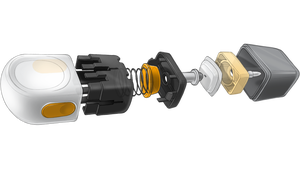Market Focus: Packaging 10014
September 21, 1998
The Colt-Ainer cosmetic jar, molded from Eastman Chemical's Eastar copolyester, features glass-like clarity and visual appeal with the product compatibility, barrier properties, and toughness essential to the cosmetics packaging industry. The material can also be readily reclaimed and recycled back into the PET waste stream. |
The Freedonia Group Inc. (Cleveland) has a new report on the packaging market for injection molding applications and includes forecast data through the beginning of the next century (Table 1). The report projects demand for injection molded packaging will increase 3.4 percent annually to 3.9 billion lb in 2002 with advances growing from rising consumer demand for convenient packaging along with growing industrial demand for cost-effective bulk containment methods.
Thin-wall molding, downsizing, and parts consolidation will contribute to cost containment and enhanced performance for different packaging products, stimulating the most growth. Caps and closures should register the fastest gains in the market. Here are projections for all applications:
Caps and closures. Healthy growth is expected for plastic caps and closures, reflecting sustained penetration at the expense of competitive materials. This will be coupled with demand for tamper-evident and child-resistant closures, for which injection molded plastics are well suited. Growth is also expected for sophisticated closure systems, like pumps, which require more resin per unit than conventional screw caps.
Containers. Moderate advances are expected here based on increased demand for dairy products and other foods. This is tied to the market for foods such as ice cream, cottage cheese, yogurt, and others packaged in tubs and cups. Growing cosmetic, pharmaceutical, and health and beauty aid container demand will also fuel expansion. On the pharmaceutical side, Owens-Illinois and the Kerr Group are the leading molders of prescription bottles; Owens-Illinois accounts for about 85 percent of the market.
Lids and other packaging. This segment will see minimal gains due to market saturation and competition from alternative closure and sealing systems, such as foil lids.
Industrial. Healthy gains are expected in this segment due to the growth of bulk packaging systems using molded pails, totes, crates, and pallets, often at the expense of metal and wood products.
Plastic shipping containers are ideally suited for transporting corrosive products such as hazardous waste and chemicals, as well as gypsum, grains, and various other foods.
You May Also Like


